The Papagei Staffel in 1/48
After his dismissal as General der Jagdflieger by Hermann Goering at the end of December, 1944, Adolf Galland was slated to become Staffelkapitaen of 4.JG54 - at the time fighting overwhelming odds in the Courland Peninsula - as his punishment. For a Generalleutnant to be a Staffelkapitaen would have been as great a dismissal as Goering could achieve; had Galland refused, it would have been dereliction of duty in the face of the enemy, and Goering would have been within his rights to stand his greatest critic against a wall and have him shot. Fortunately for Galland, Hitler knew none of this when he suggested to the Reichsmarschall that the obstreperous Galland be given command of a Jagdstaffel of Me-262s to demonstrate what he said the airplane was capable of against the Allied air forces. Thus was born Jagdverband 44, literally "Fighting Band," with the 44 being some inner joke of Galland's regarding both his original command, 3.J/88, and his criticism of Goering. The unit was also known as Galland's Zirkus (circus).
Much has been written about Galland's unit, which was embroiled in controversy during its entire two month existence. By early April, 1945, Galland had nearly 50 Me-262s, which had come to him from the factory, and from other units as they fell apart. During the first week in April, Galland moved the unit to Munchen-Reim airport, where it would be near the main Messerschmitt factory responsible for final assembly of Me-262s, thus assuring him a supply of aircraft. The move also put JV44 squarely in the bulls-eye of the 9th Air Force, which was supporting the 7th Army in its drive to clear the German Army out of Bavaria. Once the jets were spotted, the field was under constant surveillance by P-47s and P-51s of the 9th AF fighter-bomber units, as well as the Tempests of the RAF's 2nd Tactical Air Force.
Other jet units had been protected by conventional fighter units nearby, whose Bf-109s and Fw-190D-9s could provide protection to the Me-262s when they were at their most vulnerable: during takeoff and landing. JV44 needed their own Platzshutzstaffel (Airfield Protection Squadron), and formed it in mid-April. The unit has come to be known as the Papageistaffel, but this was not used at the time, although the flight call sign Papagei (Parrot), may have been. Nicknamed the Wurgerstaffel, the three Fw-190D-9s and one Fw-190D-11 (there may have been others, these are known for certain photographically) were commanded by Leutnant Heinz Sachsenberg. That Sachsenberg had a sense of humor is demonstrated in the slogans on the four airplanes: his airplane, Fw-190D-9 Red 1, carried the slogan "Verkaaft's mei Gwand 'I foahr in Himmel" ("Sell my clothes, I'm going to heaven!"); Fw-190D-9 Red 3 carried "Im Auftrage der Reichsbahn,"("By Order of the State Railway," a reference to the manner by which a shot-down German pilot could return to his unit via the railroad); Fw-190D-11, Red 4 carried "Der nachste Herr, dieselbe Dame!" ("The next man, the same woman!"), while Oberleutnant Klaus Faber's Red 3 carried "Rein muss er und wenn wir beide weinen!" ("In he goes and then we both cry!") The double-entendre can still bring a smile, whether you understand idiomatic German or not.
So far as is known, in the two weeks of combat left for JV44, the Papageistaffel did not score any victories over Allied aircraft. The unit has become of primary interest to modelers since the discovery of the first photographs of Red 13 in the late 1980s showed the wild markings of the flight: the underside painted completely in Rot23 red, with white stripes (though at first the model gnus, er, I mean gurus, said the lower surfaces were black and white), the intention being to convince the light flak gunners defending the field that these airplanes were friendly at a glance, as they flew through the flak in pursuit of any attacking Thunderbolt or Mustang.
These were done about 10 years ago and all four models are based on the Trimaster/DML Fw-190D-9 kit, with the Fw-190D-11 utllizing the superb Wurger Mechanic resin fuselage and Ta-152 prop, though it does not have an engine plug as the others do from Parts 'r' Parts; it was painted in RLM76 and "RLM84" using a color mix from seeing a Fw-190 part painted with this color shown me by Jerry Crandall, since the Fw-190D-11s are thought to have been manufactured from rebuilt Fw-190A-8 airframes. Additionally, the Eagle Cals resin correction sets were used for the fuselage gun covers and props on the three D-9s. The Eagle Cals "Papageistaffel" decal sheet was used. The wild underside markings of these aircraft were not painted neatly - they were painted while on their gear, and the stripes should not be even in width and perfectly parallel, which is the way I did them.

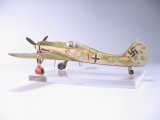
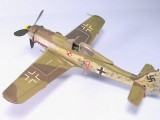
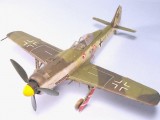
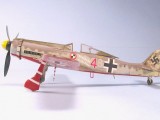

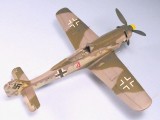
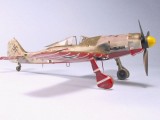
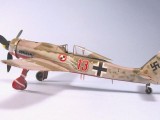
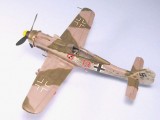
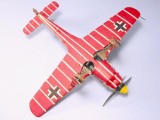
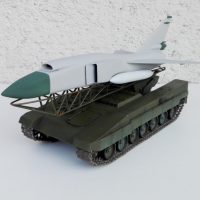
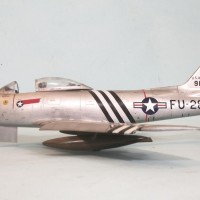
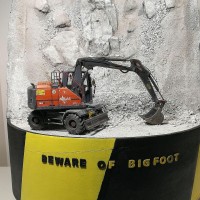
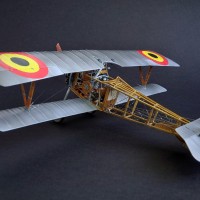
Tom...Nice work as usual and enlightening history.
Nice build Tom and a nice read too
Beautiful models and an interesting story
AFAIR the Wurger Red 3, flown by Waldemar Wubke ("In Service of the German State Railway") was (?also?) a reference to his peacetime occupation (pre-war)- a railway worker.
Great story and very cool model. Did the D-11 have the same prop and spinner/hub as the Ta-152?
Thanks!
Same prop, not sure about the spinner.